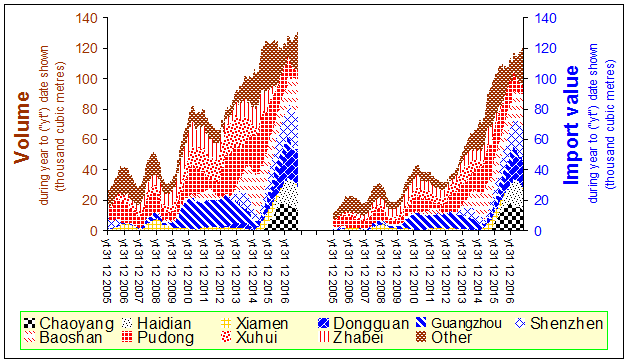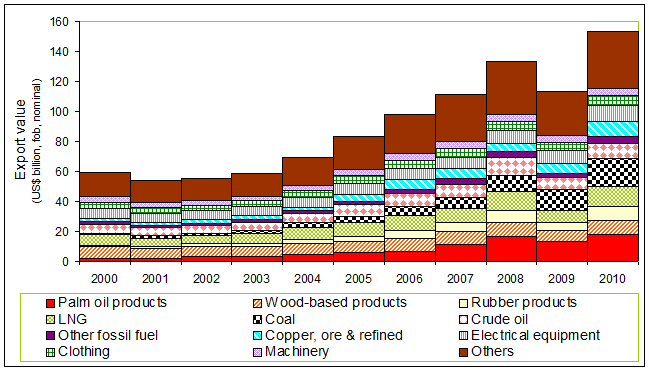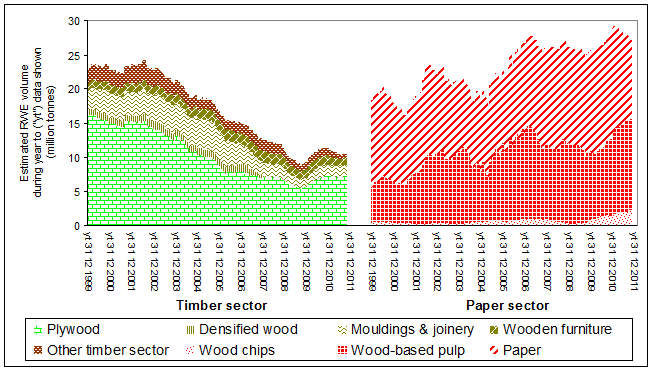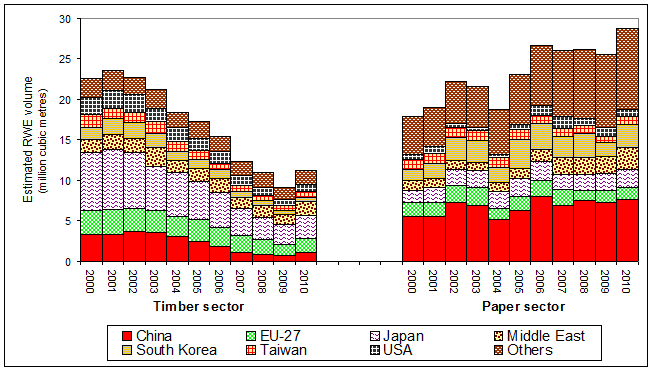|
|
||
|
|
||
|
Indonesia |
||
|
Matching
discrepancies - trade in "plywood" from Indonesia to China
China's imports of sawn merbau from Indonesia
(occupied Papua)
Trends in the export value of Indonesia's exports Indonesia's
exports of wood-based products Indonesia's
exports of wood-based products |
||
|
Indonesia is the world's third largest emitter of carbon.[Fig. 1.2] Deforestation and land-use change on what was - until recently - forest is the principal cause of Indonesia's emissions. The primary drivers for this are plantations (for palm oil and for pulp & paper) and quick profit (from the felling of timber from forest designated - perhaps improperly - for conversion but subsequently abandoned after the initial profit has been made). Those emissions are particularly large from peatland. Those who import palm oil, pulp and paper from Indonesia are culpable for those emissions and should be obliged - by consumer pressure or, preferably, multi-lateral agreements - to cease such procurement with almost immediate effect in order to mitigate the very serious risk of catastrophic climate change. During recent years, China, the EU and the Indian subcontinent have been the initial destinations for most of Indonesia's palm oil exports, China accounted for most of the pulp and much of the paper which Indonesia exports.[Part 5] Indonesia supplies a third of all producer-country exports of tropical timber - second only to Malaysia. It is also the world's leading exporter of pulp, paper, and furniture based on tropical timber (excluding rubber wood). The Indonesian government accepted that just under 90% of its timber production during 2003 was probably illegal. During 2006, the Indonesian government claimed to have reduced the quantity of illegal timber from 10 million to 3 million cubic metres. However, these figures probably ommit (perhaps deliberately, perhaps because such data might not be collected) estimates of the quantity of illegal timber which is produced for pulpwood and from Conversion Forest. Further, statistics for the Annual Allowable Cut published by the government of Indonesia and the ITTO are highly misleading in isolation - they tend to relate to only part of the forest area which is officially - but not necessary legally - authorised for logging. ITTO reports indicate that Indonesia imposed a ban on sawn wood exports during October 2004 and that this ban was relaxed from March 2006. It is remarkable therefore that the volumes of sawn wood which China, the EU, Japan, and the USA each imported monthly during 2004 changed little during 2005. The roundwood equivalent volume of Indonesia's timber exports has declined appreciably since since the early 2000s having previously been static for several years. Factors contributing to this decline include the severity of accumlated forest loss in Indonesia, the success of China (partly by using stolen Indonesian timber) in gaining market share from Indonesia, and the increasing frequency of efforts by the authorities to clamp down on illegal production and trade in timber. Because those efforts have yet to include the successful prosecution of key individuals for complicity in those illegal activities, one might argue that those efforts are little more than a token, temporary measure. Plywood accounted for half of Indonesia's timber exports (by RWE volume) in 2004, and Japan imported half of this. In terms of RWE volume, there is a substantial mismatch between the declared exports of these products and the corresponding imports that many importing countries declare. This translates into an loss to Indonesia of some US$400 million. Separately, it is said that Indonesia annually losses US$4,000 million from illegal logging. It is remarkable that Bretton Woods institutions and others do not seem to consider that short-term investment in transforming Indonesia's customs service is worthwhile. The return on investment is surely very high. The military - particularly naval - equipment that Indonesia has been persuaded to buy (much of which might be subsidised by special export credits) could be used in support of the customs service and the law (at negligible incremental cost if treated as practical experience). Unfortunately, as in many other producer countries, the military - particularly the army - (and police) is understood to be complicit in illegal timber production and trade. Countries that import Indonesian timber, pulp and paper products have driven the evolution of Indonesia's (currently anarchic) timber industry. The low unit prices which importers have secured has, inter alia, fuelled tropical timber consumption and trade, held back sound forest management, impoverished local communities and national economies, and contributed to bad governance and associated organised crime - internationally. The European Union has been the lead donor (particularly in capacity building) to Indonesia's forestry sector during the period of "transition" since the Suharto era as part of a seven-year project - due to end in mid-2004 (i.e. soon). The focus should be on greatly reducing installed milling capability and on enhancing the capacity of the Indonesia Bank Restructuring Agency to properly manage the government's commercial interests in failing timber and pulp/paper companies (and minimise the state's liability for the previous regime's lack of responsibility and investors imprudence). Although the EU (primarily the North) imports little more than 10% of Indonesia's timber exports (mainly as plywood) - the Middle East imports slightly less - those imports are sufficiently large for changes (such as the prohibition of illegal timber imports) to generate some leverage for robust reform in Indonesia's forestry and wood processing industries - including the closure of many large mills. Such reform would help minimise poverty and improve lenders' and others' confidence in doing legitimate business with Indonesia. Japan is much the most culpable importer - it imported 40% of Indonesia's timber exports during most of the 1990s and is the world's largest consumer of tropical timber. By RWE volume, Malaysia, which imports some 10% of Indonesia's timber exports (40% as logs), has for several years imported 10 times as much timber from Indonesia as Indonesia declares that it exports to Malaysia. This is indicative of the scale of illegal trade between the two countries. China is particularly responsible for driving Indonesia's (and hence other impoverished producer countries') illegal log exports. China has led the surge in Indonesia's log exports since the IMF obliged Indonesia to remove a log export ban in 1998 (the ban was re-imposed only three years later), and has developed an export-oriented processing industry largely dependent on cheap tropical logs. Further, in terms of RWE volume, China has for several years imported twice as much timber from Indonesia as Indonesia declares that it exports to China. China is also the destination for much of Indonesia's increased palm oil production. Importing half of Indonesia's pulp and paper exports, China is a major driver of Indonesia's exports (and, by extension, production) of pulp and paper. Much of this trade is between a small number of associated companies. Much may subsequently be re-exported from China. The principal such company, APP, went bankrupt but is being subsidised by the people of Indonesia by virtue of loans made by the government (- which tends to confirm that speculative investment in the timber processing industry is risk free and that the Indonesian government at least condones if not actively supports the expansion of APP at the expense of the country's forest and those whose livelihoods depend on the forest). Its auditors were Arthur Andersen. Organised crime is said to be the principal link between Indonesia's teak plantations and Indonesia's teak garden furniture producers. Indonesia is the world's leading producer of such furniture. All the output of the state-owned monopoly supplier, PT Perhutani, used to be FSC-certified. None now is - much promotional material related to such furniture is misleading. Wealthy corporate and private consumers in the EU and USA continue happily to buy much of that furniture. Importers would be prudent if they treated all wood-based products from Indonesia as being illegal (and unsustainable) - unless certified to standards equivalent to those of the FSC which demand legal compliance. It is possible for the timber trade to conduct profitable and responsible business from natural tropical forests. Organisations that are vertically integrated from forest concession through to retail outlet, such as the Tropical Forest Trust, are setting a commendable precedent rather than wait for governance in the forestry and timber processing industries to be transformed. For many years the Indonesian state has been allowed by the international community to be in breach of its constitution - to manage all resources for the well-being of all its people. With exhaustion likely later this decade in Sumatra and Kalimantan, the logging frontier has shifted to regions where ethnic tensions provoked by transmigration and the military (/politicians) are already high. Indonesia, like other producer countries, appears to have focussed on supplying basic raw material for uses in which non-tropical timber would (if the social and environmental cost of timber extraction were taken fully into account) probably have been both fit for purpose and competitively priced. In doing so it has chosen to follow the short-sighted example of the Philippines, previously a leading tropical timber supplier but now, because its forests are exhausted, obliged to meet its timber consumption by imports (requiring foreign exchange which the country can ill-afford). This has helped prevent tropical timber, with its many excellent properties, attracting a price premium. It has also held back investment in local employment (particularly on heavily populated Java) and small to medium sized enterprise in the finished and semi-finished products sector - indirectly helping its competitors develop such industries. Initial supplies of FLEGT-licenced products are scheduled to be available under the Voluntary Partnership Agreement ("VPA") between the European Union and Indonesia before he European Commission's Regulation 995/2010 (prohibiting the placement of illegal wood-based products on the EU market) is enforced (03 03 2013). It is in Indonesia's interest to meet that schedule because the legality definition[¶3 p2] for the VPA does not cover the full range of illegalities which both pertain in Indonesia and must be assessed under Regulation 995/2010. It is hoped that the Timber Legality Assurance System ("SVLK") which Indonesia is introducing will be sufficient evidence of legality for the VPA. However, obtaining the necessary unambiguous documentation might be impracticable for most legal supplies - but is fundamental to proper management[¶4 p2] of what is left of Indonesia's forest. If documentation were not a constraint, the integrity of the SVLK would probably be exceptional - because civil society (which is well motivated, not-for-profit, and has a presence nationwide) is participating[¶11] as an independent observer. The largest pulp~paper group is said to be helping develop the SVLK[-] and LEI's Sustainable Forest Management Standard[-]. Perhaps coincidentally, that group (with its affiliates) accounts for the largest number of members of the business chamber[-] of LEI and LEI is designated as an auditor of the SVLK. Many plywood mills are unable to account for the logs which they procure["A" final bullet p3][second bullet p5]- but seems to have been ignored by importers in Japan who need to comply with Japan's Green Procurement Law([final 3¶ p2]). In contrast, several importers in the EU have stopped procuring from Indonesia.[final bullet p4] The conservation status of South East Asian trees suggested by the IUCN Red List has not been revised since the 1990s - and is more likely to have become worse - even though the timber industry still generates billions of US dollars in revenue for the region and donors have ample funds. This lack of political will to manage the region's forest sustainably - reflected also in the scarcity of credible plans for management of permanent forest - is sufficient alone to justify anyone carrying out due diligence to assume that any timber exports from the region which are not demonstrably legal are associated with illegality (including corruption). Illegalities: 2) The Forest Law (revised during 1999) requires, amongst other things, that forests are managed equitably and sustainably with local communities. This is rarely respected.[2.1.1] [second bullet p5] The legal framework has been (and probably remains) so contradictory and complex that the volume of logs produced in compliance with all rules and regulations is likely to be very small, even if corruption is ignored.[¶3 p72] 3) The process of designating forest use (e.g. for community use, conversion or production of logs in perpetuity) is likely to have been improper (including corrupt). Most permanent forest concessions have not been gazetted as required and their output is consequently illegal.[p13-15] 4) Most tropical timber currently logged in Indonesia probably derives from forest conversion, very little of which was (/and, perhaps, is) likely to be legal[penultimate¶ p12]. At least 30% of the natural forest must be retained.[final¶ p2] Clearing forest using fire and converting forest on peat more than three metres deep are prohibited but not uncommon, particularly in the pulp industry [¶3&4 p4] and if officials accept statistics for the depth of peat presented by the industry. The pulp industry is also known for its use of violence[footnote15], as is the timber industry in Papua [final¶ p4] (which, according to - unenforced - international law has been occupied by Indonesia since 1961[* ]). 5) Concession management plans are likely to have been approved improperly, especially in occupied-Papua.[¶1 p3] 6) Concessionnaires or their logging contractors might not be eligible to carry out logging, and concessions might be improperly allocated, perhaps on behalf of others.[¶11] [¶3 pii] Although ordered to withdraw from commerce[*][p23], the military probably continues to have substantial indirect interest in logging (plywood [p7][*] and palm oil), particularly in occupied-Papua[final¶ p6 & ¶3-5 p8], Kalimantan[p64-65] and Aceh[*], and with foreign "investors"[final¶ p39] Relatives and cronies of former President Suharto probably continue to have interests in timber production. 7) Much of the long established timber and pulp industry has benefitted from a weak financial regulatory environment to obtain low cost financing, exceed legal lending limits, divert central bank liquidity credits, and profit through financial mark-up schemes.[¶1 p18] 8) Although Indonesia was the first country to include forest-related crimes as predicate offences for prosectuion for money laundering[¶1&2 p18], this has had little impact - partly due to incompatible leglislation in Singapore and Hong Kong[*]. 9) The quantities of mouldings and sawn wood exported to China and Taiwan tend to differ greatly from the corresponding quantities reported as imports by China and Taiwan (implying customs fraud). Evaluating
illegal exports: 2) Mouldings - assume illegal unless (or even if) 100% certified to at least FSC standards with full chain of custody to certified concession with reputable concessionaire and logging contractor. 3) Joinery - assume illegal if made at least partly from tropical forest species unless 100% certified as in 2) Mouldings above. Its content of plantation-grown or legal imported timber is largely irrelevant. 4) Furniture and ornaments - assume illegal if made at least partly from tropical forest species other than teak (Tectona grandis) or mahogany (Swietenia macrophylla) which are grown on plantations in Indonesia. Although the latter is listed in CITES, the listing is confined to trade in logs, sawn wood, veneer and plywood, not furniture. Supplies of teak tend to be supplied by one quasi state-owned enterprise alleged to be associated with violence.[*] It is likely that less than half of total number of items of wooden furniture which Indonesia exports includes wood from tropical forest. 5) Fibreboard and particleboard - assume illegal if made at least partly from tropical forest species (including mill residues). In terms of roundwood equivalent volume, the amount made from mill waste should not account towards the total of illegal timber exported - in order to avoid double counting with the product milled. 6) Plywood - assume illegal unless the supply for all the tropical timber from which sheets of plywood (and blockboard) are made is credibly certified as legal (including the concession, etc.). 7) Wood chips - assume legal if from plantations established on forest land prior to 1994, but bear in mind the probable links between the supplier and either of two major pulp milling groups. 8) Wood-based pulp - assume illegal if any tropical timber is used in the mills which make the pulp or if the mill or plantation has been fraudulently established, except (perhaps) if they were established prior to 1994 (to be consistent with the FSC rules for forest conversion). Bear in mind the repute of the groups which mill pulp wholly from plantations established prior to 1994. 9) Paper - assume illegal if it is made at least partly from illegal pulp (see 8) Wood-based pulp above). 10) Although Indonesia is said to have lost US$5 billion during 2002 due to the failure of most loggers to pay royalties[Table 2.3], there is little correlation between this and Indonesia's exports of illegal wood-based products (either during 2002 or now). Estimates which assume that negative results for the equation Production plus Imports minus Exports minus Local End-use[*] [p94&95] are based on imprecise data and conversion factors. By ignoring the many important illegalities which are known to take place, they are arguably irrelevant. Nevertheless, they have been useful.
|
||
|
Copyright
globaltimber.org.uk
|





